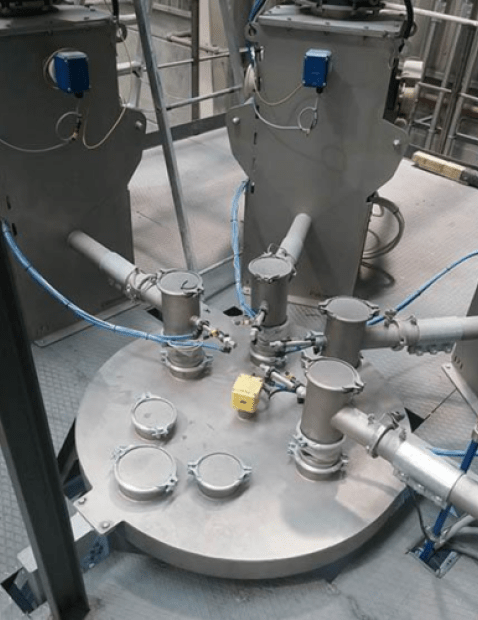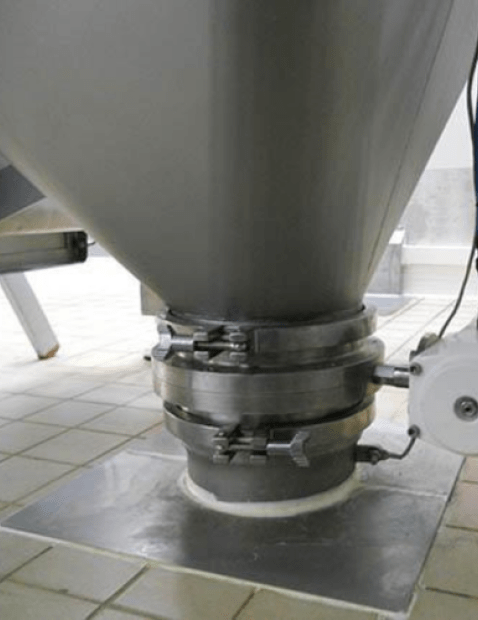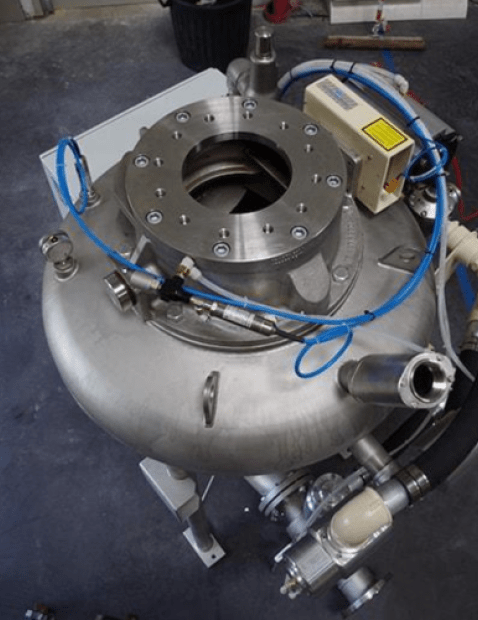The choice of the dosing system will depend on 4 main factors:
- The precision of the metering
- The rate of progress
- The type of application (batch or continuous)
- The type of powder (grain size, density, flowability)
1. Accuracy: volumetric dosing or weight dosing?
Terms and definitions:
The volumetric dosing works on the principle of counting the number of revolutions and the operating time of the screw feeder.
The weight dosing will include load cells (load cells) that control the screw rotation speed and operating time.
Volumetric screw feeder:
Volumetric dosing is mainly used for single material applications and continuous dosing.
The dosing rate depends on the screw diameter.
The design of the volumetricbatching unit is optimized to facilitate screw feeding and thus ensure consistent dosing. This dosing accuracy is in the range of 3% to 5%.
Several types (profiles) of screws are available depending on the grain size and density of your powders and raw materials.
When installing the volumetric dispenser, a test phase is necessary to ensure calibration. For example, for a test phase of 1 min at 60 rpm, we dose 1.8 kg. In this case, this setting is valid only for the type of powder tested.
From an economic point of view, the volumetric dispenser represents an advantage over the weight dispenser.
Weight screw feeder:
However, processes requiring traceability of batches cannot integrate this type of equipment.
Weight dispensers are perfect for batch operations. The load cells (force sensors) installed in the equipment ensure that the screw motor is controlled according to the setpoint given. Thus, during batch operation, 3 cycles follow one another:
- High speed dosing
- Low speed dosing (10% of high speed)
- Fall tail
During continuous operation the servo is in real time.
Unlike volumetric dosing, weight dosing is self-adaptive, so it is perfectly suited for multi-product dosing.
The use of continuous weight dosers offers a dosing quality with a variability of less than 2%. In batch operation, the accuracy drops to 3g.
The weight feeder has 2 main operating principles:
Weight loss operation and weight gain operation.
In the case of weight-loss operation, the load cells are located on the dosing unit. For weight-loss operation and continuous dosing mode, the re-feed time must be extremely short (ration 1/10). During the re-feeding phase, the weight dispenser functions as a volumetric dispenser.
In the case of weight-gain operation, the load cells are installed on the container (hopper, deconditioning pot, bags...)
Note: It is essential to be careful with weighing interference. For example, the use of specific sleeves is necessary to ensure the quality of the dosage and avoid constraints on the weight sensors.

If your require further assistance,
I am at your entire disposal.
Loïc, powder expert
2. Type of powders: screw feeder or vibrating feeder?
Powders have many characteristics: grain size, flowability, brittleness and abrasiveness. These factors are very important in determining the dosage solution
Screw feeders are the most adaptable family for different types of powders.
Screw feeders are suitable for fine, dusty, variable density, medium flowability powders thanks to the different types of screws available. Food powders such as cocoa powders, spices (curry, spice mix...), texturizers are common applications for Palamatic Process screw dispensers.
The dosing of fragile or delicate ingredients such as glass fibres, dried fruit, abrasive materials or coarse-grained powders and granules is particularly suitable for the vibrating dosing unit.
The vibrating feeder can be operated in volumetric dosing or weight dosing. The vibrating feeder is suitable for the treatment of fragile and low-dust powders.
The operation of the vibrating feeder is identical to that of the screw feeder:
- High speed dosing
- Low speed dosing (10% of high speed)
- Fall tail
Different types of vibrating troughs can be installed such as tubular troughs, single or double channel open troughs. The choice of the type of trough will depend on the hygienic requirements and the desired flow rate.
Vibrating and screw feeders can also manage the commercial weighing and therefore the final packing of your raw materials.
3. Alternative dosing equipment
Alternative dosing equipment is also available in the Palamatic Process range for applications requiring less precision constraints:
- Butterfly valve or knife gate valve: controlled by a 4-20mA proportional actuator. They can manage a very high flow rate with medium accuracy. Suitable for all types of powders and bulk materials (fine, dusty, coarse, bulk...)
- Rotary valve: suitable for processing fine powders with high hygienic constraints. The accuracy is in the range of ½ litre.
- Rotary airlock valve: suitable for continuous dosing of fine powders. The accuracy is in the range of one litre.




















